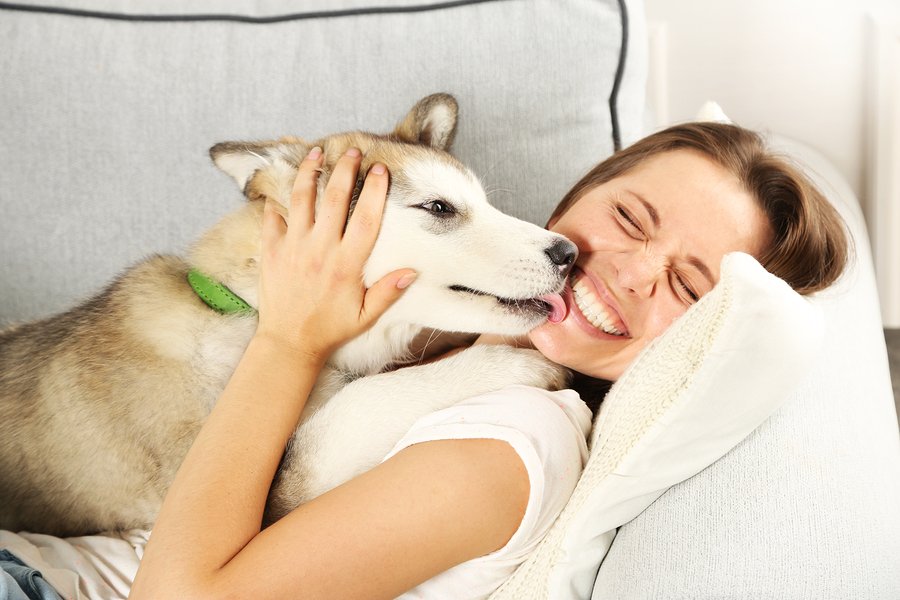BIGSTOCK

Remember the time your dog (pick one) ate the turkey off the kitchen counter; rolled in another dog’s excrement; scared that nice old lady who lives across the street; or wouldn’t come when you called, and you yelled at him to behave? How’d that work out for you?
Yup, that has been our experience, too. Yelling at a dog is about as useful a solution for getting him to change his behavior as getting him to eat more slowly or stop shedding. The directive just doesn’t compute. Why not?
There are a number of reasons. For instance, some dogs would rather be yelled at than ignored. They think, any attention is better than none.
But the overarching reason dogs don’t do what you want in response to yelling is that their brains can’t translate a harsh voice into the behavior you desire. All they know is that you’re angry; yelling doesn’t provide them with a blueprint for how to conduct themselves in a way that will please you. In fact, it does the opposite, making a dog less likely to be able to follow your directions than he would be otherwise.
Who can think straight when they know someone is angry at them and, to boot, isn’t equipped with the tools to fix the situation because he doesn’t know the behavior you would prefer? It’s the equivalent of a couple in an argument: “You know what you did.” No, he doesn’t. And more importantly, you’ll get a lot more mileage out of training your dog to behave as you wish by telling him what to do rather than to focus on what he shouldn’t have done. That’s water under the bridge.
In addition, don’t underestimate the power of avoiding situations that will get your canine pal into trouble. For instance, if you pull the Christmas turkey out of the oven and your dog happens to like turkey (we’ve heard of a few who do), don’t leave the bird unattended on the kitchen counter and walk out of the room. Why set your dog up for failure? Likewise, don’t let him near old Mrs. So-and-So as she steps out of her house. Maybe her cane or her unsteady gait unnerves him.
Using avoidance to help your dog behave does not make you a weak owner. It makes you a family member with common sense, just as you would be for a human family member. Think about it: if your loved one hates Ferris wheels, you’re not going to insist that he go on one. That would only serve to further sensitize him to the thing that sets him off. Same with dogs.
Here are four other New Year’s resolutions besides not yelling that it’s worth making for your dog’s well-being—and your positive relationship with him. They’re all about “being the person your dog already thinks you are,” says Nicholas Dodman, BVMS, DACVB, Director of the Animal Behavior Clinic at Tufts. “Your dog worships you and loves you unconditionally, greeting you enthusiastically when you come home no matter what. He considers you to be his best friend.”
That is, what you have going for you is that your dog does very much want to please you, even if it doesn’t always seem that way. Show him the ropes — take time to train him — and he really will come forward. It involves more work than just yelling at him after the fact, but also reaps much greater rewards.
“Most dogs have this optimistic view of their owners,” Dr. Dodman relates. “They think the person they live with is the best thing since sliced bread. Making the commitment to do right by your canine pet is a matter of living up to that opinion of you.” And doing so will come back to you in the form of an even better relationship. As the Beatles sang, “the love you take is equal to the love you make.” Simply put, send love your dog’s way and he will send it back to you big time.
1) I will give my dog the exercise he needs.
Exercise does not mean you make sure your dog relieves himself outside, hangs out in the backyard by himself, or takes a couple of walks on leash with you every day. All those are fine, but they do not replace vigorous physical activity. A dog’s body, just like a person’s, is meant to really work. His heartbeat should go up, he should pant a little, and he should feel at least a little fatigued by the activity. Not having that physical outlet everyday not only isn’t good for a dog’s body, it also isn’t good for his brain.
Exercise boosts the brain’s levels of serotonin, just as it does for people, and thereby helps bring on a feeling of calm. It also allows a dog to meet his biologic potential for releasing considerable amounts of energy, for which he is genetically primed. Yes, dogs evolved sleeping up to 14 hours a day, but in between bouts of sleeping, they roamed their territory hunting prey. This was not delicate work, and even today they still require physical outlets.
These can come in the form of your engaging with your pal in rigorous games of catch, working with him on agility courses or signing him up for fly ball or lure or herding courses, or taking walks in the woods and other places where he can roam freely at his own pace and then come back to you when you’re ready. Remember, a tired dog is a happy dog, but just as importantly, a tired dog is a dog much less likely to get into mischief and therefore results in a happy owner.
2) I will be consistent in my application of rules.
You know the axiom, “Rules are made to be broken”? Whoever came up with it wasn’t thinking of dogs. Dogs are very uncomfortable without consistent rules, even if it doesn’t seem that way.
Think of a dog who likes to come to the table for scraps of your food. If you give him scraps sometimes and, annoyed, tell him to stop hankering for morsels from your meal at others, he will become not only confused but also very ill at ease. Dogs feel secure when life is predictable, even if that means things are not always as they would like them. Sometimes-yes-and-sometimes-no makes them very anxious. “Imagine a classroom of kids with no clear rules and then the kids being punished for going too far without ever knowing what ‘too far’ is,” says Tufts animal behaviorist Stephanie Borns-Weil, DVM.
Such inconsistency makes dogs act like gamblers. A dog owner might think that a dog is pushing his limits when he expects a scrap from the table every time and should just be glad for “sometimes.” But your canine loved one is not trying to push his limits or wear you down. He’s simply thinking that if it worked once he can get it to work again, the way someone pulling the lever on a slot machine knows that if he keeps trying, it will happen eventually because it has happened before. That is, it’s an instinct to keep trying because it might work, not an effort to nag you until you “give in.” And it does not make a dog happy to invest in this exercise. It only makes him nervous. Do gamblers seem happy when they keep investing more and more as they pull that lever?
The only way to keep a dog from entering into that anxious state that might mistakenly seem for all the world like a battle of wills is to never raise his expectations if you don’t plan to follow through every single time. What that means is that if you don’t always want to give him scraps at the table, never give them. If you don’t always want him in bed with you, never let him climb up in the first place. And so on.
You’re not being cruel. You’re deciding where you feel okay about indulging your dog and where you don’t, and the structure and predictability will serve him and make him more compliant and even happier. He won’t have to keep wondering why the “system” works sometimes and not others and what he has to do to get it to operate correctly. That’s just too much for a dog to handle.
BIGSTOCK

3) I will make sure my dog has lots of fun things to do, and I will do some of those things with him.
It is not enough to just take your dog for walks and then let him sleep or otherwise be alone the rest of the day without anything to do. Play with him. Throw a ball, have him chase you around the house, teach him new tricks, engage with him. Leaving him with nothing to do is like putting someone in a padded cell.
You are not alone if you have not been interacting enough with your pet. Boredom is the scourge of dogs. Their owners often get them home as young puppies, housetrain them, engage them in some basic command training, and may even enroll them in a puppy training class. But many dogs, long before they are a year old, are left alone for several hours at a stretch, or even for the entire day, with absolutely nothing to occupy their minds and bodies. Leaving the television on for your pet and knowing that he will bark at the mailman won’t cut it. In fact, leaving a dog with nothing to do for long periods is cruel. It’s akin to leaving a preschooler alone in the house all day with no distractions.
If you can’t be home with your dog much of the time, leave him food puzzles and other toys with which to while away the hours. But even then, don’t underestimate your own role in your dog’s environmental enrichment. Dogs have been bred to be very people-oriented. They depend on their owners not only for varied activities but also for a sense of family in general. With your human family members, you can sit and watch TV and have the shared experience of dissecting an episode of a show you like to see together. With your dog, you have to “think dog,” as it were. He’s not comfortable just hanging out on the couch after your long day away from him. He loves you and wants to interact with you.
4) I will remember to praise my dog for doing the right thing.
It is all too easy to fall into a routine of reprimanding your dog for doing the wrong thing while failing to reinforce his compliance with praise. But it means a lot to a dog to be praised by his owner. Our experience at Tufts has demonstrated time and again that our canine pals behave better — and more consistently — when they are rewarded for their good actions rather than punished for their bad ones.
It’s a paradigm shift from the approach still put forth by a number of popular schools of dog training, even though animal behaviorists have known for more than 100 years that rewards work wonders. Psychologist Edward Thorndike showed at the beginning of the 1900s that you can teach a dog (and a number of other species) a lot more effectively by rewarding the right response than by punishing the wrong one. Positive reinforcement not only works more quickly but also more effectively over the long term. This has been shown to be true for people as well as animals.
It makes sense. Punishment, aside from making a dog anxious and miserable, teaches him nothing other than how to avoid punishment — and completely breaks down the bond between person and pet. All trust is eroded, in no small part because you have to keep punishing to get the desired effect. But rewards like praise, stroking on the muzzle, and delicious treats now and then in response to good deportment allow your dog to take the good feelings from situation to situation and help keep him better behaved in general.
They’ll make you feel better, too. You love your dog. Why would you want to make him feel bad for getting things wrong when you can do a lot more for your relationship by making him feel good for getting things right?





